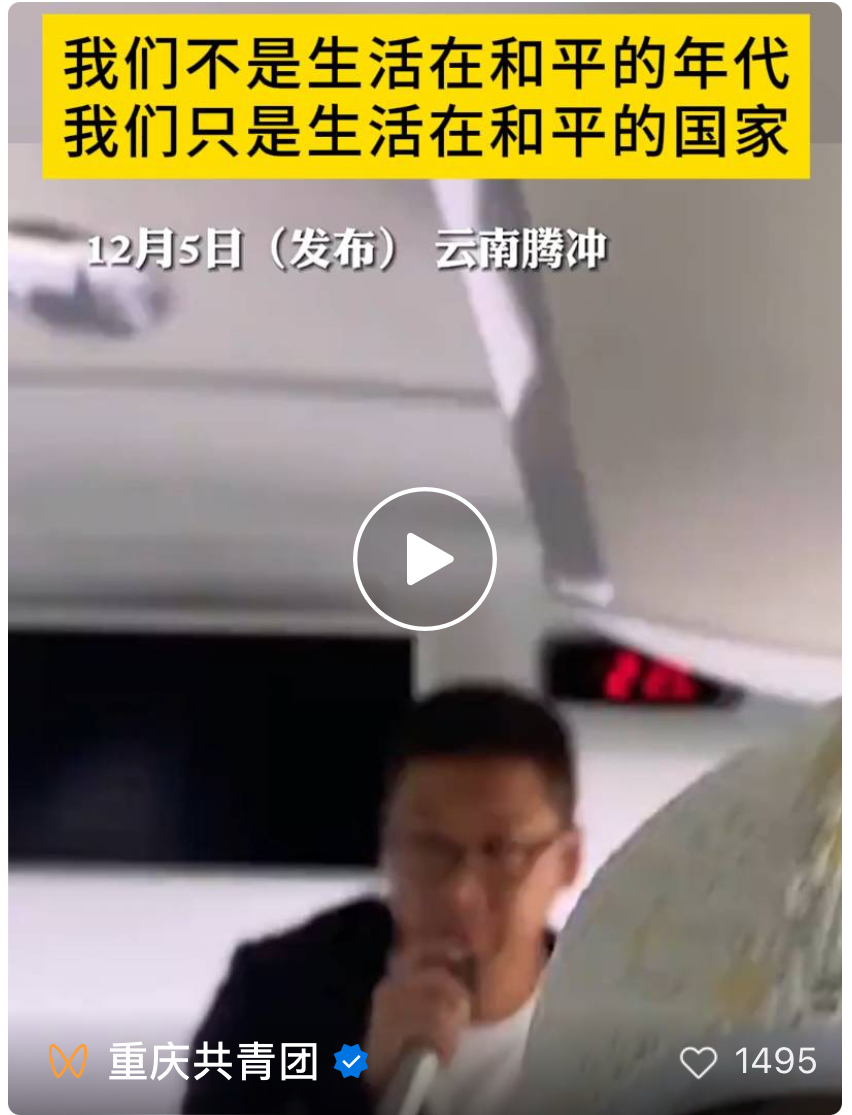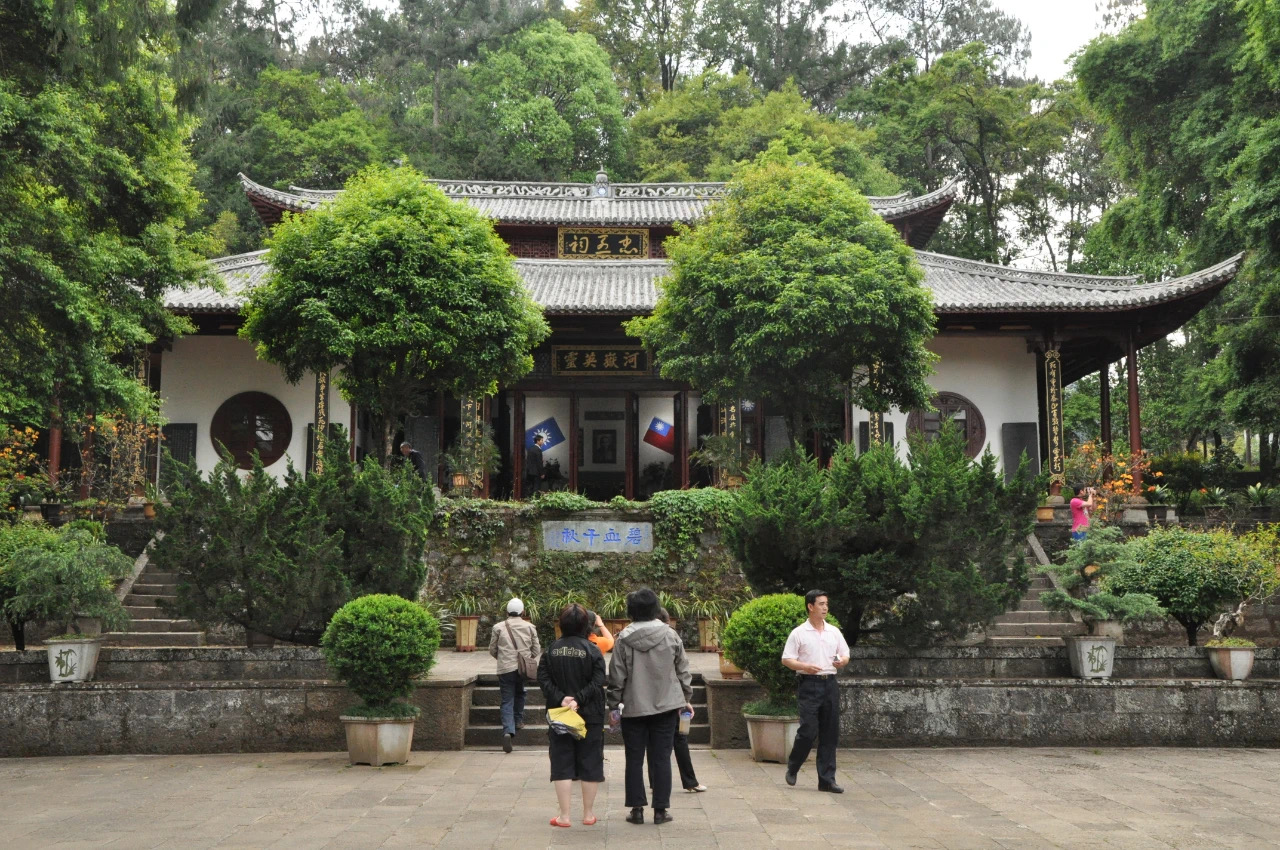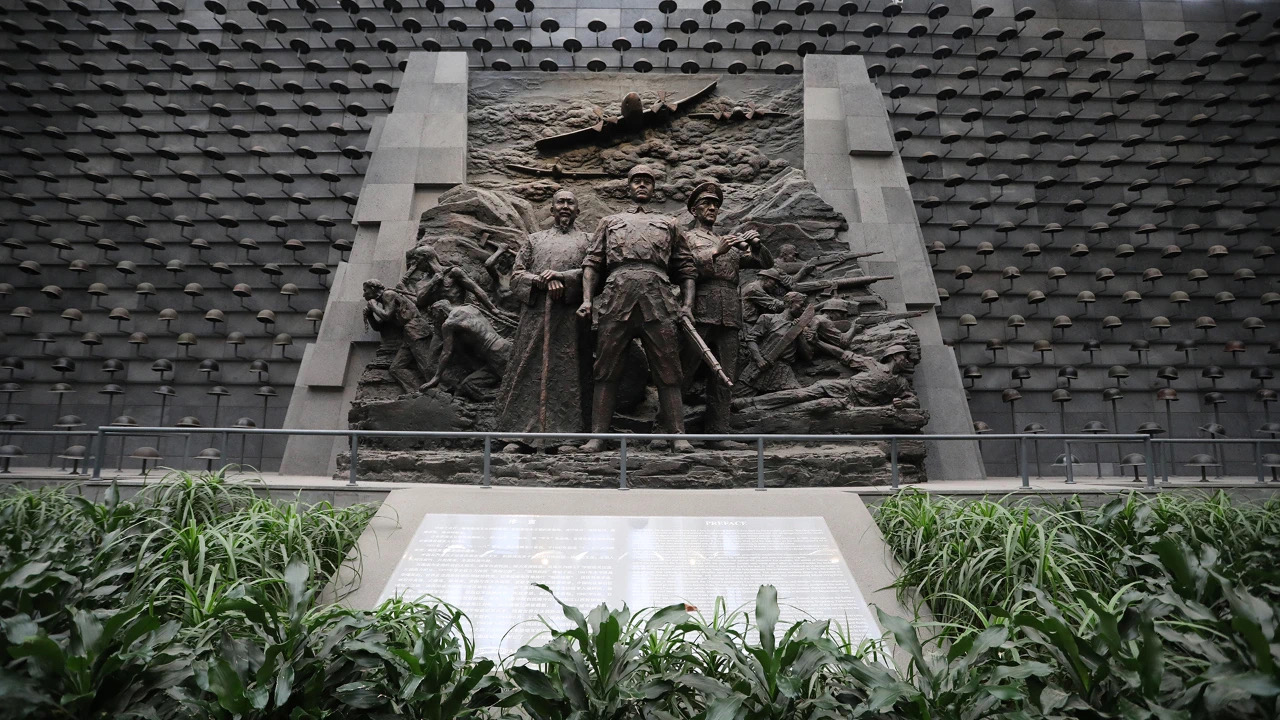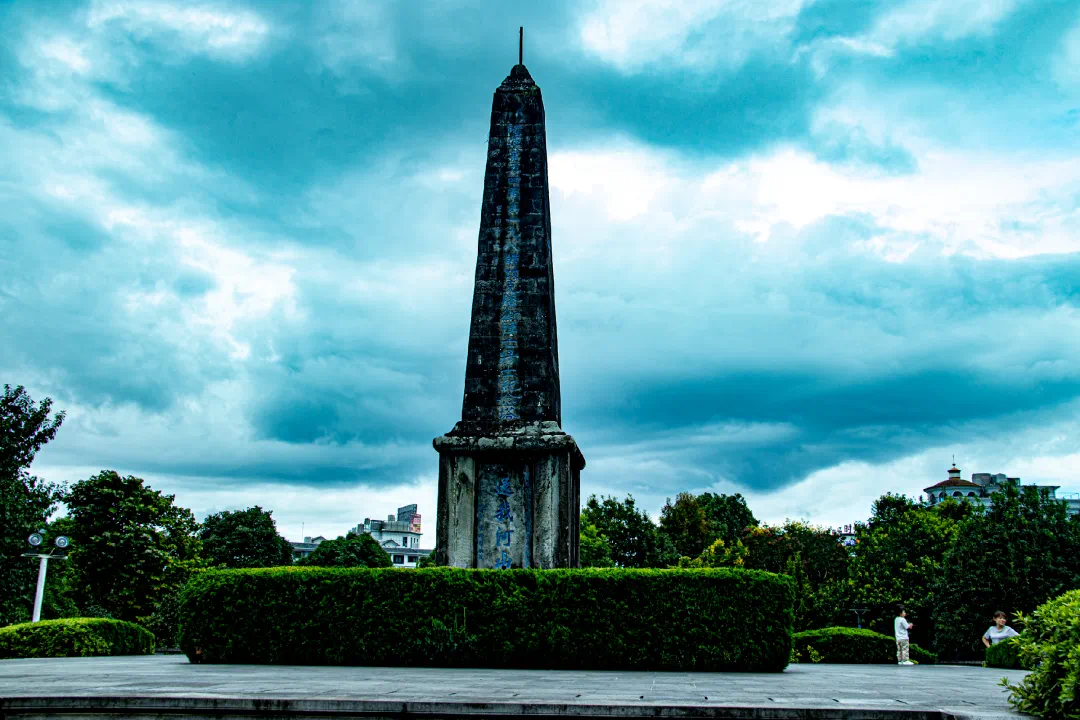recently
A "Yunnan tour guide advises tourists to buy chrysanthemums for martyrs.
The short video drew netizens' attention
And became a hot search on Weibo

In the video, on a tour bus
The guide said with emotion:
"If possible, please prepare 5 yuan.
Buy a chrysanthemum tomorrow,
To these dearest and dearest people."

In the comments
Many netizens have agreed
Some Yunnan netizens said
"Every year on Tomb-sweeping Day, Tengchong people, old and young, go to sweep the graves."


The place the guide mentioned in the video is exactly
Tengchong City War Cemetery, western Yunnan Anti-Japanese War Memorial Hall
Tengchong National War Cemetery, West Yunnan Anti-Japanese War Memorial Hall is located in Tengchong City, 1 km southwest of the river Dieshui under the small group slope, the whole park (hall) area of 53300 square meters. It receives more than 1.4 million visitors every year, and is an important place for the broad masses of the people to visit, mourn, and carry out patriotic education. It is also an important carrier for many experts and scholars to understand the culture of the War of Resistance and engage in research on the War of Resistance, with great social impact.
In August 2014, the National War Cemetery and the West Yunnan Anti-Japanese War Memorial Hall were announced by The State Council as "the first batch of national Anti-Japanese War facilities and sites";
In August 2014, Western Yunnan Anti-Japanese War Memorial Hall was awarded the title of "Cross-Straits Exchange Base" by Taiwan Work Office of the CPC Central Committee and Taiwan Affairs Office of the State Council;
In July 2018, it was awarded the honorary title of "Advanced Collective of National Cultural Relics System" by the Ministry of Human Resources and Social Security and the State Administration of Cultural Heritage.

National War Cemetery
In May 1942, the Japanese Army invaded the border of western Yunnan, and a large area of land west of the Nujiang River fell into the hands of the enemy, and the only international passage behind the Anti-Japanese War of China - Burma Road was completely cut off. In May 1944, the Chinese expeditionary Force launched a counterattack in western Yunnan in order to recover the lost territory in western Yunnan, open up the major international transportation artery in southwest China - Burma Road, and enable the Allies' aid materials to enter China smoothly, and finally win the overall victory of the Anti-Japanese War.

The 20th Group Army of the right wing of the expeditionary force with six divisions (including the troops directly under the expeditionary force) forcibly crossed the Nujiang River, attacked the Gaoligong Mountain, and fought bloody battles in the south and North. Then, with the cooperation of the Allies, they besieged Tengchong City and launched deadly street battles with the enemy. After 43 days of bloody battles, they completely wiped out the Japanese invaders on September 14, 1944, and recovered the first city since the Anti-Japanese War - Tengchong. The battle killed more than 6,000 Japanese soldiers, 9,168 expeditionary officers and soldiers, and 19 Allied (American) officers and soldiers were killed.

After the liberation of Tengchong, in order to commemorate the fallen soldiers and the dead people, Mr. Li Yuanquan, a member of the National Government and a Yunnan-Guizhou supervision envoy at the time, proposed that "it should be a monument to the memorial mound, to sacrifice the spirit, shape the sound, and pass on the historical records", and proposed the construction of a cemetery. Construction began in the winter of 1944 and was completed on July 7, 1945 (the eighth anniversary of the Lugou Bridge Incident).

The whole park covers an area of 37,884 square meters, the park is covered with green pines and cypress, the environment is quiet and solemn. The main building consists of the gate, memorial hall, martyrs' tomb, memorial tower, Allied monument, Chinese expeditionary Army memorial square, stele gallery, etc. There are engravings of the inscriptions, couplets, poems, eulogies of Chiang Zhongzheng, Yu Youren, Li Yuanquan, Wei Lihuang, Huo Guizhang and other military generals and local patriots, as well as important inscriptions such as the Book of Answer to Tiandao, the Book of the Fathers of Western Yunnan, and the Notice of the Military Committee of the National Government. There are 3,346 tombstones of soldiers killed in the Battle of Tengchong and 19 Allied soldiers in the park. In addition, the remains of the soldiers of the expeditionary forces who moved here from Namkham, Lashio, and Mong Yau in Myanmar are also buried. There is a new large relief stone wall 60 meters long and 4 meters high, and 10 groups of copper statues; Chinese expeditionary Force anti-Japanese soldiers monument.

In the 1980s, the Tengchong government carried out protective repairs on the National War Cemetery, and in June 1984, it was announced as a "county-level key cultural relic protection unit". 1986 Established "Tengchong County War Cemetery Management" management organization; In February 1987, it was announced as "Yunnan Province level key cultural relics protection Unit". In 1994, it was named "West Yunnan Anti-Japanese War Memorial Hall" by the Propaganda Department of the Central Committee. In 1995, Tengchong National War Cemetery was rated as "Excellent patriotic Education Base of National Cultural relics System"; In November 1996, it was announced by The State Council as a "National Key cultural relic protection unit"; In November 2005, it was named "National Patriotic Education Demonstration Base" by the Propaganda Department of the Central Committee. It was officially opened to the public for free on September 14, 2008. In December 2009, the National War Cemetery was named the National Defense Education Demonstration Base by the National Defense Office; In June 2011, it was announced by the National Red Tourism Office as the second batch of national red tourism classic scenic spots; In December 2017, it was selected into the second batch of China's 20th century architectural heritage.

Western Yunnan Anti-Japanese War Memorial Hall
The memorial Hall is located on the east side of the National War Cemetery, covering an area of 14,677 square meters, construction area of 9,492 square meters, Chen exhibition area of 6,000 square meters, the project began construction in December 2010, and was completed on August 15, 2013 and open to the outside for free, with a total investment of 150 million yuan, is one of the 12 major cultural facilities construction projects in Yunnan Province.

The memorial hall is integrated with the former National War Cemetery to fully and truly display the history of the Yunnan-Burma-India War of Resistance. It is a special memorial hall of the War of Resistance with a distinct theme, powerful, magnificent and precise content, and integrates multiple functions such as exhibition, collection, research, viewing and education.

The building of the memorial hall adopts a frame structure, forming a "V" shape, implying the meaning of victory. The main exhibition area adopts the method of multi-space three-dimensional exhibition, focusing on the physical objects of the Anti-Japanese War, taking into account pictures, text and video data, highlighting the effect and appeal of the Chen exhibition.

The exhibition hall is divided into: the rear of the Anti-Japanese War, the front line of the enemy, the Nujiang confrontation, the Jedi counterattack, the evacuation of the invaders, the veterans will not die, praying for peace, the World War II soldier exhibition, the Japanese bacteriological war crimes exhibition, General Que Hanqian's relics exhibition, the exhibition area of more than 6,000 square meters, the collection of more than 100,000 pieces of physical objects, the exhibition of 22,000 pieces of physical objects, 1700 pictures.

The Chinese Expeditionary Force List Wall is the main subsidiary project of the memorial hall, built on the west side of the memorial hall, with a total length of 133 meters, engraved with more than 100,000 Chinese expeditionary Force soldiers, Allied soldiers, local anti-Japanese guerrillas, local casualties in the war, and troops and units involved in the war.

Tips
Location: Under the slope of Tengchong River
Ticket: None (ID card required)
Opening hours: Tuesday to Friday 9:00 am - 17:00 PM daily, weekends 9:00 am - 17:30 PM daily. The museum will be closed all day on Monday and open on legal holidays and important anniversaries.
Related reading:
8.15 Commemoration of the 74th anniversary of the victory of the Anti-Japanese War! West Yunnan Anti-Japanese War Memorial Tengchong punch card recommended
Impression | Walking into the Memorial Hall of the Anti-Japanese War in western Yunnan: the tragic memory of the anti-Japanese soldiers and people who bravely went to the country and looked death in the face
A post-1995 docent's hand painting - "National War Cemetery"
Good news | The National War Cemetery has been included in the second batch of China's 20th-century architectural heritage list
Tengchong City was an important battlefield in the Anti-Japanese War
Many brave soldiers rose up to fight the war
Wrote a heroic song in defense of the country
In addition to Tengchong City war Cemetery, West Yunnan Anti-Japanese War Memorial Hall
Let's walk in together
These red tourist attractions in Tengchong City
The Eschi House
The former residence of Esqi is located on the high and open hillside in the north of Longtan, Shuitui-cun, Heshun Town, Tengchong City. The former residence, built in 1919, is a two-story building of Chinese wooden structure Siheyuan, composed of main room, hall, wing, garden, gate, statue and other buildings. In the former residence, the pictures and objects of Aisqi Comrade's life are displayed, which play a very important role in the propaganda and education of patriotism.

Li Yuanquan old residence
The original building was destroyed in the Xianfeng and Tongzhi dynasties of Qing Dynasty. After the victory of the Anti-Japanese War in West Yunnan Province, Li Yuanquan rebuilt his house on the original site and named it "Diayuan", a traditional wooden structure Siheyuan building. In August 1989, the descendants of Li Yuanyuan donated the property rights of Dianyuan to the Tengchong government, established the management office of Li Yuanyuan's former residence in the same year, and expropriated 1353 square meters of land, and successively set up buildings such as galleries, gates and stele corridors, officially opened to the outside world in 1998, announced in 1999 as the provincial patriotic education base, announced in 2003 as the provincial cultural relics protection unit. And renamed the old residence management office of Li Root.
Lai Fengshan Anti-Japanese War site
Laifeng Mountain anti-Japanese Battlefield site, located in the south of Tengchong City, Laifeng Mountain, the peak elevation of 1921 meters, the area of about 2 square kilometers, has been Tengchong City's main support and military defense. After the Japanese army occupied Tengchong in 1942, it used the favorable terrain here to build a large number of pillbox fortifications as the main position to garrison Tengchong City. In July 1944, the 20th Army of the Chinese Expeditionary Force surrounded Tengchong on three sides. On July 17, the 116th Division, the 36th Division, and the 2nd Reserve Division of the Expeditionary Force launched a comprehensive siege of Laifeng Mountain, and after 13 days of fierce fighting, they defeated the four major points of Ying, Mei, Song, and Chenghe set up by the Japanese on the mountain on 29, creating favorable conditions for the full-scale siege of Tengchong City in the future. Today, a large number of bunkers, trenches, craters and other remnants of combat can still be seen on the mountain.

198 Division Memorial Tower
In 1944, the 198th Division of the 54th Army of the National Revolutionary Army was transferred to participate in the counteroffensive war in Western Yunnan as the General reserve of the 20th Group Army. In the capture of Tengchong City and the clearing of Gaoligong Mountain and the two sides of the Nu River, 198 Division killed 156 officers and 1,335 soldiers. In order to commemorate the soldiers killed in the Tengchong counterattack campaign, the division built a memorial tower at the foot of Laifeng Mountain in Tengchong after the war. On the front, the 54th Army commander Que Hanqian titled "The 198th Division of the 54th Army captured the Tengchong Memorial Tower", and the seat of Chiang Zhongzheng titled "The Light of the nation". The pagoda is a precious historical relic that witnessed the Tengchong counterattack of the Anti-Japanese War in western Yunnan, and plays an extremely important role in patriotic education.

Related reading:
Provincial cultural protection unit: 1980 Division memorial Tower
Qushi Jiang Ju ancient town anti-Japanese county government site
Jiang Tho Wengong is the former site of Tengchong anti-Japanese County Government, and also one of the key places for the relocation of more than 40 offices of twenty-four Tengchong anti-Japanese County Government. As a base for patriotic education

The smoke clears, peace and quiet
Just as the tour guide Duan Fei said
"We do not live in peaceful times
We just live in a peaceful country."
No matter how long it's been
That history, that time
Still in mind, never dare to forget
Do not forget history, revitalize China!
Cherish the memory of the martyrs, our self-improvement!
Source: Baoshan News Network

【Qiao Yunnan】The "lively" hometown of overseas Chinese and Shun Ancient Town hope that overseas children often "go home" to see

Today's Winter Solstice | Time is quiet, with white dew and frost. The winter solstice has arrived, and the fleeting year is peaceful

Thousands of miles of mountains and rivers celebrate together, wishing the country prosperity and the family prosperity! Warm Celebration of the 75th Anniversary of the Founding of the People